The Sad Book
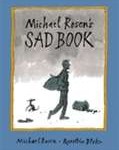 It is with deep sadness that my family said goodbye today to Leo. Leo was an affectionate, opinionated, mostly blind, mostly deaf, 18-year-old ginger cat. He was a good friend, and he will be greatly missed.
It is with deep sadness that my family said goodbye today to Leo. Leo was an affectionate, opinionated, mostly blind, mostly deaf, 18-year-old ginger cat. He was a good friend, and he will be greatly missed.
In honor of Leo and for all those who know what it’s like to be sad, this week I’m sharing Michael Rosen’s Sad Book written by Michael Rosen and illustrated by Quentin Blake. This beautifully thoughtful picture book works even for preschoolers and kindergartners, because it shows how sadness feels in honest, child-friendly terms. “Sometimes I want to talk about all this to someone. Like my mum…. Sometimes I don’t want to talk about it. Not to anyone…. I just want to think about it on my own. Because it’s mine. And no one else’s.”
Rosen writes about some things that help him when he feels sad: “Every day I try to do one thing I can be proud of. Then, when I go to bed, I think very, very, very hard about this one thing.” But never does Rosen downplay the truth of the emotion, or sugar-coat it, or say any other falsely cheerful things that don’t ring true to those children who do know what real sadness is. For children who’ve suffered a devastating loss, this could be just the right book.
After sharing this book, or parts of this book, with your children, look again at the first two pictures, the one where Rosen is smiling (“Maybe you think I’m happy in this picture. Really I’m sad but pretending I’m happy”) and the next page where we see how Rosen really feels, all grays and glum. Let children draw pictures of themselves, either how they feel or how they want people to see them. Talk about times when we’ve felt sad, and what helps. For Rosen, birthday cakes and candles and remembering those he loved helps. For many of us, reading a truthful, wonderful book like Michael Rosen’s Sad Book helps, too.
For more information, visit michaelrosen.co.uk or quentinblake.com.
Read More
The Little Old Lady Who Was Not Afraid of Anything
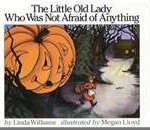 Halloween is coming, and do you know what is scarier than a pumpkin head floating all by itself? Seeing how much my book budget has been slashed for next year! AHHHHHHHHH! Perhaps you, too, have limited funds but an unlimited desire for good children’s books. In the next few weeks, I’m sharing some of my favorite classic books that should be easy to get at your local library, in case you’re finding it tricky to get your hands on all the new books you’d love to have.
Halloween is coming, and do you know what is scarier than a pumpkin head floating all by itself? Seeing how much my book budget has been slashed for next year! AHHHHHHHHH! Perhaps you, too, have limited funds but an unlimited desire for good children’s books. In the next few weeks, I’m sharing some of my favorite classic books that should be easy to get at your local library, in case you’re finding it tricky to get your hands on all the new books you’d love to have.
The Little Old Lady Who Was Not Afraid of Anything written by Linda Williams and illustrated by Megan Lloyd is one of those books I can’t resist using every year. Even when she’s followed home by scary things, like two shoes going CLOMP, CLOMP and one shirt going SHAKE, SHAKE, this little old lady is not afraid. In fact, she takes all those scary things and puts them to good use, making a scarecrow to keep crows away from her garden.
This cumulative story is perfect for a feltboard or magnetic board retelling. Cut pieces of felt into the shapes of the shoes, shirt, etc., or draw those objects on paper and glue them to magnets (I always grab extra free magnets from pizza parlors and drugstores just to make magnet stories). Kids can use the pieces to retell the story. Keep the book handy with the pieces so kids can refer back to the book as they retell. I know some teachers who aren’t afraid of anything (though I would never refer to them as little old ladies) who brought in real shoes, shirt, pants, etc. to build a life-size version of this story in their classrooms. Enjoy sharing The Little Old Lady Who Wasn’t Afraid of Anything with your students, but beware: after one reading, you may find your classroom full of shoes that go STOMP, STOMP and many voices saying “More, more!”
Read MoreCan You Make a Scary Face?
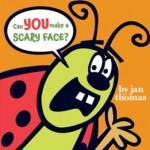 With Halloween approaching, I’m on the lookout for spooky stories, and this one caught my eye: Can You Make a Scary Face? by Jan Thomas. It is the ultimate participation picture book, and your wiggly ones will love it. A big, goofy ladybug gets kids to stand up, sit down, wiggle imaginary bugs off noses and shirts, and even chicken dance. When a giant, hungry frog comes along, the ladybug needs the readers’ help to scare him away: “Help! Make a scary face NOW!” Turn the page and see both the frog and the ladybug looking frightened. “Yikes! Not THAT scary!” With bold, bright pictures that will work for large groups and the scary parts all played out by the readers, this is a terrific book for little ones who aren’t ready for ghosts and ghouls. After reading, challenge your little ones to make the scariest faces they can, and play “The Monster Mash” so kids can dance and move in “scary” ways. You’ll have lots of happy faces by the end of storytime.
With Halloween approaching, I’m on the lookout for spooky stories, and this one caught my eye: Can You Make a Scary Face? by Jan Thomas. It is the ultimate participation picture book, and your wiggly ones will love it. A big, goofy ladybug gets kids to stand up, sit down, wiggle imaginary bugs off noses and shirts, and even chicken dance. When a giant, hungry frog comes along, the ladybug needs the readers’ help to scare him away: “Help! Make a scary face NOW!” Turn the page and see both the frog and the ladybug looking frightened. “Yikes! Not THAT scary!” With bold, bright pictures that will work for large groups and the scary parts all played out by the readers, this is a terrific book for little ones who aren’t ready for ghosts and ghouls. After reading, challenge your little ones to make the scariest faces they can, and play “The Monster Mash” so kids can dance and move in “scary” ways. You’ll have lots of happy faces by the end of storytime.
For more information, visit janthomasbooks.com.
Read MoreDo You Know Which Ones Will Grow?
 Before I rave about Do You Know Which Ones Will Grow? by Susan A. Shea and Tom Slaughter, first I must rave about the public librarians in Washington. I just spent a day talking about great books and ideas with some of the most dedicated, hardworking, professional librarians I’ve ever had the pleasure to meet. These librarians do it all in their eastern Washington libraries, and I am inspired by them to do more when I get back to my library in Michigan.
Before I rave about Do You Know Which Ones Will Grow? by Susan A. Shea and Tom Slaughter, first I must rave about the public librarians in Washington. I just spent a day talking about great books and ideas with some of the most dedicated, hardworking, professional librarians I’ve ever had the pleasure to meet. These librarians do it all in their eastern Washington libraries, and I am inspired by them to do more when I get back to my library in Michigan.
But if I’m spreading the love this morning, I have to send some love to Susan A. Shea and Tom Slaughter for this book.
“If a snakelet becomes a snake, can a cupcake grow and become a (lift-the-flap) cake?”
How do I love thee, Do You Know Which Ones Will Grow? Let me count the ways.
1.I didn’t know they were called snakelets, so yay for learning vocabulary in context.
2. Nothing like lifting a flap to grab a young audience.
3. The flaps are actually sturdy enough to withstand multiple readings.
4. Love the rhyming practice we get to guess the right answer.
5. Half way through the book, we stop to get the answer (yes to these, no to those) and then we go to round two, which ends with a baby grows to become – you!
6. Tom Slaughter’s art is yummy.
This works wonderfully for the early science units on living and non-living things. An easy extension idea for non-crafty folks like myself is to give students a large piece of construction paper folded in half. At the top of the page, write “Do you know which ones will grow?” One one half of the page, write “Yes” and write on the other half “No”. Kids can choose die-cut shapes, or shapes cut from magazines, to glue on the appropriate side. Cute for a class book or a bulletin board, too. You know all your students will grow to love this book.
For more information, visit tomslaughter.com
Read MoreMINE!
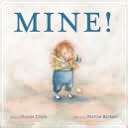 When I first saw MINE! written by Shutta Crum and illustrated by Patrice Barton, I thought it’d be fun to use with my little ones in storytime. After all, it’s about two toddlers (and the cutest, drooly puppy) learning how to share a pile of toys. So, it’s a book for toddlers, right? But then I thought of how my kids giggle over laughing baby videos on Youtube. Who doesn’t love silly, little babies? MINE! is a great book to build early reading confidence for preschoolers and kindergartners. The text is simpler than simple: “Mine!”, “Mi-“, and “Woof!”, and the pictures are so cute. Before reading this book, ask your listeners if they have little brothers, sisters, cousins, who are grabby. Chances are, you’ll see lots of hands waving and heads nodding. Read MINE! to the group and let kids share stories about babies they know, or stories about themselves as babies. Then, let your readers who need a confidence boost practice this story to perform for Readers’ Theater. It is such a fun, easy read, you’ll have all your readers saying MINE!
When I first saw MINE! written by Shutta Crum and illustrated by Patrice Barton, I thought it’d be fun to use with my little ones in storytime. After all, it’s about two toddlers (and the cutest, drooly puppy) learning how to share a pile of toys. So, it’s a book for toddlers, right? But then I thought of how my kids giggle over laughing baby videos on Youtube. Who doesn’t love silly, little babies? MINE! is a great book to build early reading confidence for preschoolers and kindergartners. The text is simpler than simple: “Mine!”, “Mi-“, and “Woof!”, and the pictures are so cute. Before reading this book, ask your listeners if they have little brothers, sisters, cousins, who are grabby. Chances are, you’ll see lots of hands waving and heads nodding. Read MINE! to the group and let kids share stories about babies they know, or stories about themselves as babies. Then, let your readers who need a confidence boost practice this story to perform for Readers’ Theater. It is such a fun, easy read, you’ll have all your readers saying MINE!
For more information, visit shutta.com or patricebarton.com.
Read MoreBig Bag of Buffalo Goodness!
 Jealous? I know. I would be, too, if I were you. But I’m me, happy, happy me, with my swag bag of buffalo goodies from the ultra-talented and super-generous Audrey Vernick!
Jealous? I know. I would be, too, if I were you. But I’m me, happy, happy me, with my swag bag of buffalo goodies from the ultra-talented and super-generous Audrey Vernick!
Audrey is the author of a number of swell books, including two I’m crazy for: Is Your Buffalo Ready for Kindergarten? and Teach Your Buffalo to Play the Drums. (Both are illustrated by Daniel Jennewin and, from the looks of his art, he’s a pretty cool guy.) On her cool website (literaryfriendships.wordpress.com) Audrey had a contest for best/worst first day of school memory and guess who won the prize? Me! For bravely sharing my embarrassing memory of my first two days of kindergarten, I now have a signed copy of the Buffalo Kindergarten book, a nifty Buffalo Drum bag, and a Buffalo notebook! (Wondering what I did on my first two days of kindergarten? Offer me something good and I’ll tell you.)
Audrey also has a new middle-grade novel out called Water Balloon that I can’t wait to get my hands on. The reviews have been stellar, and if it’s half as good as her Buffalo books, we’re all in for a real treat. Until then, I will slip my new Buffalo notebook out of its Buffalo bag and make a new list of must-read-and-share books for 2011. Keep the Buffalo books coming, Audrey, and thanks!
Read More
Gilbert Goldfish Wants a Pet
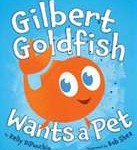 Gilbert seems to have everything his fishy heart could want, but he longs for a pet of his own. At first the visiting dog seems like an ideal pet, but he drinks from Gilbert’s bowl, and barks. A lot. The mouse runs away, and the fly gets swatted. Finally, Gilbert gets a pet! One that’s not too loud, not too rude, not too squished – one with whiskers!
Gilbert seems to have everything his fishy heart could want, but he longs for a pet of his own. At first the visiting dog seems like an ideal pet, but he drinks from Gilbert’s bowl, and barks. A lot. The mouse runs away, and the fly gets swatted. Finally, Gilbert gets a pet! One that’s not too loud, not too rude, not too squished – one with whiskers!
Kelly DiPucchio and Bob Shea have teamed up to make a fish tale worth reading again and again. The suspense over what kind of pet will work for a fish will hook readers until the very last line.
Use this book to dive into a fun graphing lesson. Make a bar graph showing the pets your students have and discuss the data. Do more students have dogs or cats? How many have fish? How many have fish that have their very own pets? Super-brave teachers and parents may be inspired to get a pet after reading Gilbert Goldfish Wants a Pet. And some of us may try to bring back the pet rock fad.
For more information, visit kellydipucchio.com or bobshea.com.
Read More






